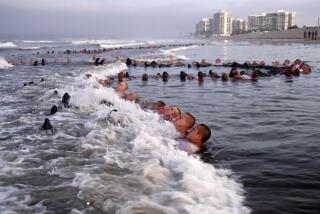Navy Officials Struggling to Grasp Admiral’s Suicide
- Share via
WASHINGTON — Military officials and colleagues of Adm. Jeremy Michael Boorda strained Friday to understand why questions raised about his service decorations would have prompted him to take his own life, as apparently indicated by suicide notes he left behind.
Amid an outpouring of sympathy over the personal tragedy that befell the Navy’s former top admiral, civilian officials and military personnel in the Pentagon’s offices and hallways were at a loss to explain how Boorda could have reacted so strongly.
Although the Navy declined to make the notes public, U.S. officials said that the admiral expressed anxiety that the revelation might result in another scandal for the Navy, which already has been plagued with its share of embarrassments this year.
Defense Secretary William J. Perry, speaking at an Armed Forces Day gathering at Andrews Air Force Base near here, praised Boorda--who had served as chief of naval operations since April 1994--as a patriot who cared deeply about rank-and-file sailors.
“I relied on his advice, I loved his spirit and I admired his love for the Navy and its people,” Perry said. “His untimely death is a terrible blow to his family, but it is also a loss to the Navy, to the Department of Defense, indeed, to the nation.”
Yet questions remained. Navy officials said that Boorda initially wore “Combat V” pins on two of his Vietnam War medals without specific authorization but removed them a year ago when questions were raised about whether he was entitled to wear them. He said it was a mistake based on a misunderstanding.
Boorda, 57, shot himself Wednesday shortly after learning that Newsweek magazine was preparing an article about the controversy.
Military officers are divided both over whether Boorda actually was entitled to wear the pins and over how important such an indiscretion would have been.
Roger Charles, a former Marine Corps lieutenant colonel who first investigated Boorda’s record a year ago for the National Security News Service, a research organization, argued that the shame from such an error would be considerable for an officer of Boorda’s high rank and position.
“It may be a real puzzle to civilians, but it would be a major embarrassment for someone [like Boorda] to be caught doing this,” Charles said.
Robert W. Gaskin, a retired Air Force colonel, agreed. It would be bad enough in the case of a lower-ranking service member, Gaskin said. “But the CNO has to be above reproach,” he said. “This is one area where you don’t make a mistake.”
But several other recently retired senior officers, who asked that they not be quoted by name, said that the question of whether Boorda mistakenly wore a Combat V pin on the two ribbons would not have been regarded as all that important.
Indeed, senior Pentagon officials expressed skepticism that much would have happened had the admiral merely owned up to the error and told civilian higher-ups that he had been mistaken. “I can’t imagine” that he would have been fired, one top official said.
There appears to be considerable confusion over whether Boorda even strayed from the rules in wearing the V (for valor) pins.
Under current regulations, no one may wear a Combat V pin unless it is specifically authorized on the formal citation that accompanies the medal. Neither of the citations for the two Boorda medals made any mention of a Combat V pin.
A directive from the secretary of the Navy, issued in 1965 when the first of the two Boorda medals was awarded, says that the “V” may be worn only if the award is “for acts or services involving direct participation in combat operations.”
But the citation for one of the two medals in question praises Boorda for “meritorious service while . . . operating in combat missions” and a second--for meritorious achievement--describes his service as “including combat operations.”
Retired Adm. Elmo R. Zumwalt, who was chief of naval operations during one of the periods covered by Boorda’s medals, said Friday that it was common practice in the mid-1960s and 1970s for recipients to wear the Combat V if they served in a combat zone.
“Anytime I got asked that sort of question, I said, ‘Wear it!’ ” Zumwalt said in a telephone interview. “I strongly believe that Mike Boorda believed he had the right to wear it and, in my tenure, when I was CNO, I would have said: ‘Yes, wear it.’ ”
What has particularly disturbed Boorda supporters and detractors alike is a gnawing feeling that the admiral--who had achieved so much throughout his career--would not have taken his own life over the Combat V issue alone.
Analysts pointed out that the CNO had been under tremendous pressure recently in handling flaps ranging from a series of crashes involving F-14 fighter jets to a scandal at the U.S. Naval Academy.
He had been under fire from a series of critics, from former Navy Secretary James H. Webb to an anonymous officer writing in the independent Navy Times. There is speculation that, when the latest set of charges hit, something inside him might have snapped.
Zumwalt and many other of Boorda’s Navy friends believe that he might have been worried that the press and Congress would blow the whole matter out of proportion. “I don’t think what Boorda feared was the facts,” one officer said. “I think what he feared was the [potential] hype.”
More to Read
Sign up for Essential California
The most important California stories and recommendations in your inbox every morning.
You may occasionally receive promotional content from the Los Angeles Times.










